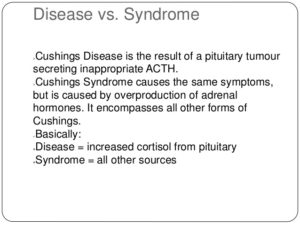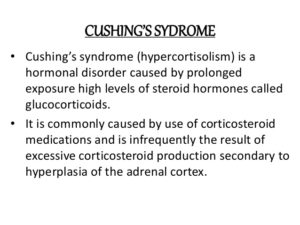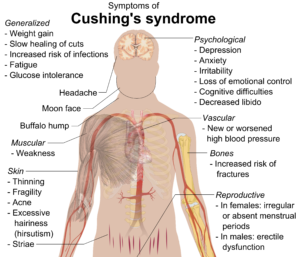Cushing’s syndrome describes the signs and symptoms associated with prolonged exposure to inappropriately high levels of the hormone cortisol. This can be caused by taking glucocorticoid drugs, or diseases that result in excess cortisol, adrenocorticotropic hormone (ACTH), or CRH levels.
Cushing’s syndrome appears when the body’s tissues are display to immoderate levels of cortisol for long periods of time.
There are two types of the disease and they are known as exogenous and endogenous. Exogenous Cushing syndrome is caused by something outside of the body, like when hormones are given to a patient during a RX for another condition.
Endogenous is caused by natural causing problems within the body. Endogenous is likely to be hereditary and not caused by an outside force like a steroid complex.
Causes of Cushing Syndrome
The most common cause of Cushing’s syndrome is exogenous administration of glucocorticoids prescribed by a health care practitioner to treat other diseases (called iatrogenic Cushing’s syndrome). This can be an effect of corticosteroid treatment of a variety of disorders such as asthma and rheumatoid arthritis, or in immunosuppression after an organ transplant.
Administration of synthetic ACTH(adrenocorticotropichormone) is also possible, but ACTH is less often prescribed due to cost and lesser utility. Although rare, Cushing’s syndrome can also be due to the use of medroxyprogesterone In this form of Cushing’s, the adrenal glands atrophy due to lack of stimulation by ACTH, since glucocorticoids downregulate production of ACTH. Cushing syndrome in childhood usually results from use of glucocorticoid medication.
Endogenous Cushing’s syndrome results from some derangement of the body’s own system of secreting cortisol. Normally, ACTH is released from the pituitary gland when necessary to stimulate the release of cortisol from the adrenal glands.
In pituitary Cushing’s, a benign pituitary adenoma secretes ACTH. This is also known as Cushing’s disease and is responsible for 70% of endogenous Cushing’s syndrome.
In adrenal Cushing’s, excess cortisol is produced by adrenal gland tumors, hyperplastic adrenal glands, or adrenal glands with nodular adrenal hyperplasia.
Tumors outside the normal pituitary-adrenal system can produce ACTH (occasionally with CRH) that affects the adrenal glands. This etiology is called ectopic or paraneoplastic Cushing’s disease and is seen in diseases like small cell lung cancer.
Finally, rare cases of CRH-secreting tumors (without ACTH secretion) have been reported, which stimulates pituitary ACTH production.
Pseudo-Cushing’s syndrome
Elevated levels of total cortisol can also be due to estrogen found in oral contraceptive pills that contain a mixture of estrogen and progesterone, leading to Pseudo-Cushing’s syndrome. Estrogen can cause an increase of cortisol-binding globulin and thereby cause the total cortisol level to be elevated. However, the total free cortisol, which is the active hormone in the body, as measured by a 24 hour urine collection for urinary free cortisol, is normal.
Epidemiology
Iatrogenic Cushing’s syndrome (caused by treatment with corticosteroids) is the most common form of Cushing’s syndrome.
Symptoms of Cushings Syndrome
Symptom of cushings syndrome include fat deposits close to the face neck and trunk; weariness; muscular weakness; salt and water retention; acne; leisurely bruising; menstlruall irregularities; and signs (in women) of virilisation, such as increase of the voice, commute in body, shape, loss of scalp hair, and extend in facial and body hair. Complications of cushings syndrome include advanced blood pressure, The symptoms and signs of cushings syndrome induced by a chronic redundant of corticosteroid hormones in the blood. The redundant may be acquired by a tumour of the outer part (cortex) of the adrenal gland, or may be referable to over inspiration of the adrenal glands by a tumour the pituitary gland.
Many children and teenagers with Cushing’s syndrome will exhibit various symptoms of the following:
-extreme weight gain
-growth retardation
-missed periods in teenage girls
-excess hair growth
-acne
-reddish-blue streaks on the skin
-high blood pressure
-tiredness and weakness
-either very early or late puberty
Adults with the disease may also have symptoms of intense weight gain, redundant hair growth, high blood pressure, and skin difficulties. In addition, they may show:
-muscle and bone weakness
-moodiness, irritability, or depression
-sleep disturbances
-high blood sugar
-menstrual disorders in women and diminished fertility in men


